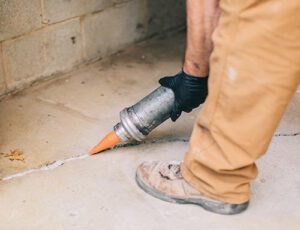The first step in concrete repair is to prepare the area. Dampen it using a plastic or burlap sheet. The area needs to be completely dry, as the new concrete will have to mix with the old concrete slowly. The longer the surface is moist, the less likely it will shrink. Then, you will need to apply a certain amount of force to compaction the repaired area. Once the process is complete, you will need to harden the repaired area. Concrete Services can determine the best options for your concrete repair thus ensuring quality output.

Once the repair area has been prepared, you should mark it. If it has board marks, draw horizontal lines parallel to the board marks. If it’s concrete that has been exposed to weather, you should use a diamond core drill of 10-20 mm diameter to mark the corners of the breakout. The diamond core drill will create relief at the breakout points, and help prevent spalling. If the repair area is large, you may need to do more.
Next, you will need to cure the repaired areas. If you don’t have a high-pressure sprayer, you can use a wet cheesecloth or burlap sack. Some contractors will use a spray-on curing compound. It is important to follow the manufacturer’s recommendations when using a repair mortar. You should always measure the area and purchase only enough material for the job. Otherwise, the leftover package will lose its efficacy.
Cracked areas can be easily identified with the naked eye. If you have to deal with larger areas, consider a mechanical breaker or a heavy-duty trowel. Ensure that the area is as level as possible. This will prevent the concrete from spreading. This will make the repair much easier. Concrete is not always easy to fix, so be sure to take your time and hire a professional to do the job.
After the concrete repair is complete, it’s important to prepare the area for it to hold up properly. Remove crumbled areas using a heavy-duty trowel or a cold chisel. Then, vacuum it to remove debris. When you’re ready to start the concrete repair, follow the manufacturer’s instructions to prevent the concrete from spalling. In this way, you will avoid any issues and will have a perfect, functional repair.
Another step in concrete repair is curing the area. After curing the area, the repair mortar must be spread evenly over the area. You can do this with a cheesecloth or a burlap sack. However, it is crucial to carefully measure the area before and after the repair to prevent it from spreading too thin. A full-scale concrete repair should last up to a year. If you need it sooner, it’s best to contact a professional and have it done.
The process begins with identifying the problem and evaluating the damage. This involves determining the cause of the damage. Often, cracking is the result of improper handling, which may result in severe cracking. Once the cracks are spotted, the repair should be done as quickly as possible. If the damage is extensive, the repair process will take longer than usual. If the problem is caused by a previous defect, the damage could occur again.
The most basic concrete repair job requires careful preparation. The damaged area should be cut out and cleaned before the repair process starts. If there are areas of concrete that are crumbling, you should remove them. Alternatively, you can cut out and clean the reinforced steel. Then, the repair process will be much easier. If you don’t have any experience in this type of work, consult a professional. Then, the next step is to prepare the area with a professional.
When repairing a concrete slab, it is important to prepare the area for the repair process. First, make sure the area is completely clear of loose edges or crumbling areas. You should also remove all cracks and rusty areas. In some cases, you may need to take drastic measures such as removing the floorboards and resurfacing the entire slab. You should be careful and follow the guidelines to avoid causing a mess when repairing concrete.